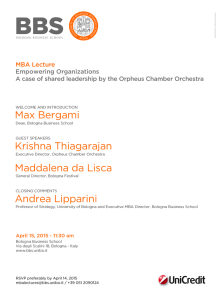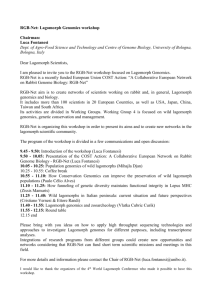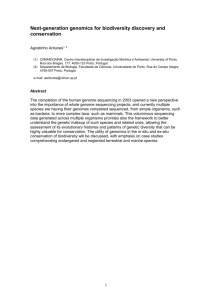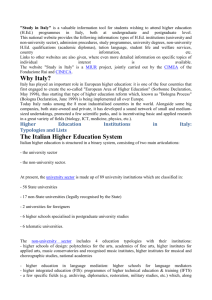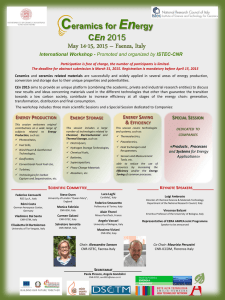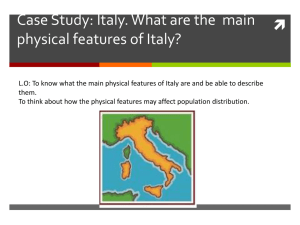Summary report of the first Lagomorph Genomics Meeting, 18
advertisement
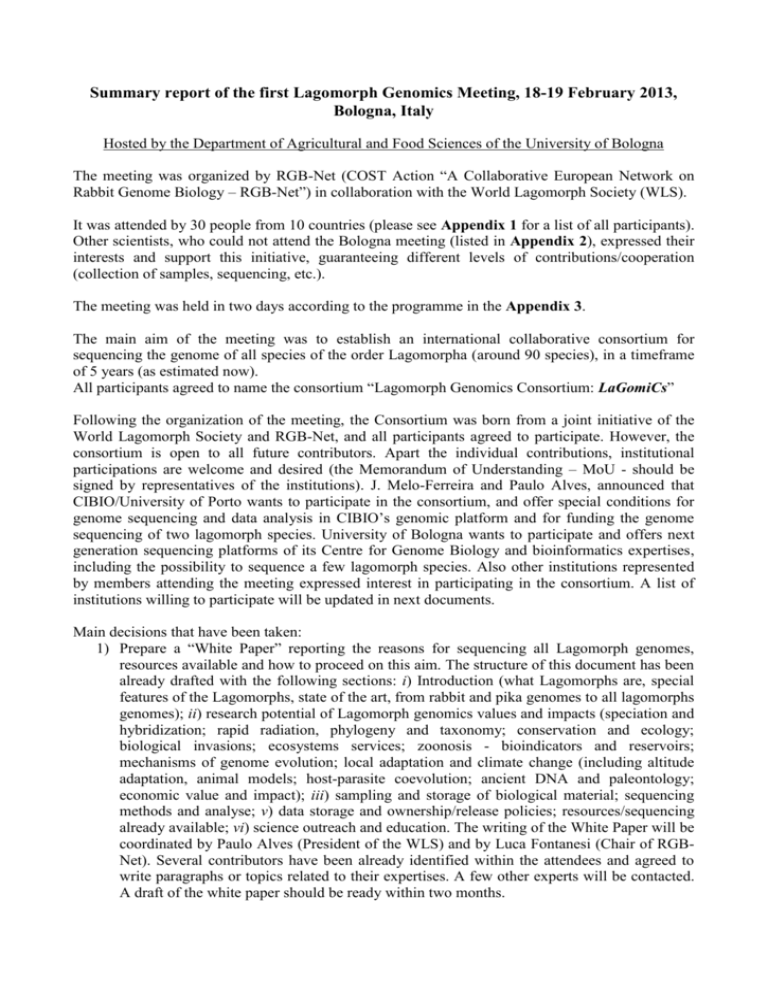
Summary report of the first Lagomorph Genomics Meeting, 18-19 February 2013, Bologna, Italy Hosted by the Department of Agricultural and Food Sciences of the University of Bologna The meeting was organized by RGB-Net (COST Action “A Collaborative European Network on Rabbit Genome Biology – RGB-Net”) in collaboration with the World Lagomorph Society (WLS). It was attended by 30 people from 10 countries (please see Appendix 1 for a list of all participants). Other scientists, who could not attend the Bologna meeting (listed in Appendix 2), expressed their interests and support this initiative, guaranteeing different levels of contributions/cooperation (collection of samples, sequencing, etc.). The meeting was held in two days according to the programme in the Appendix 3. The main aim of the meeting was to establish an international collaborative consortium for sequencing the genome of all species of the order Lagomorpha (around 90 species), in a timeframe of 5 years (as estimated now). All participants agreed to name the consortium “Lagomorph Genomics Consortium: LaGomiCs” Following the organization of the meeting, the Consortium was born from a joint initiative of the World Lagomorph Society and RGB-Net, and all participants agreed to participate. However, the consortium is open to all future contributors. Apart the individual contributions, institutional participations are welcome and desired (the Memorandum of Understanding – MoU - should be signed by representatives of the institutions). J. Melo-Ferreira and Paulo Alves, announced that CIBIO/University of Porto wants to participate in the consortium, and offer special conditions for genome sequencing and data analysis in CIBIO’s genomic platform and for funding the genome sequencing of two lagomorph species. University of Bologna wants to participate and offers next generation sequencing platforms of its Centre for Genome Biology and bioinformatics expertises, including the possibility to sequence a few lagomorph species. Also other institutions represented by members attending the meeting expressed interest in participating in the consortium. A list of institutions willing to participate will be updated in next documents. Main decisions that have been taken: 1) Prepare a “White Paper” reporting the reasons for sequencing all Lagomorph genomes, resources available and how to proceed on this aim. The structure of this document has been already drafted with the following sections: i) Introduction (what Lagomorphs are, special features of the Lagomorphs, state of the art, from rabbit and pika genomes to all lagomorphs genomes); ii) research potential of Lagomorph genomics values and impacts (speciation and hybridization; rapid radiation, phylogeny and taxonomy; conservation and ecology; biological invasions; ecosystems services; zoonosis - bioindicators and reservoirs; mechanisms of genome evolution; local adaptation and climate change (including altitude adaptation, animal models; host-parasite coevolution; ancient DNA and paleontology; economic value and impact); iii) sampling and storage of biological material; sequencing methods and analyse; v) data storage and ownership/release policies; resources/sequencing already available; vi) science outreach and education. The writing of the White Paper will be coordinated by Paulo Alves (President of the WLS) and by Luca Fontanesi (Chair of RGBNet). Several contributors have been already identified within the attendees and agreed to write paragraphs or topics related to their expertises. A few other experts will be contacted. A draft of the white paper should be ready within two months. 2) Based on the White Paper draft, a brief introductoria paper will be produced to send to scientific journals. 3) A review on lagomorph genomics will be prepared (identified journal: Mammal Review?). It will be useful for PhD students to contribute to the writing to this paper as an introduction for their thesis. 4) A Web page will be prepared and hosted by the University of Bologna. It will include a summary of the white paper, list of people and research institutions joining the LaGomiCs consortium. The LaGomiCs webpage will have links on the following existing webpages: World Lagomorph Society, RGB, departments from the participants, ??? 5) A Memorandum of Understanding (MoU) will be produced to regulate sharing of samples, data and resources, and to establish the rules. This document will be prepared just after the White Paper (or in parallel if needed by the activities of consortium’s members). 6) The next LaGomiCs appointment will be based on an electronic conference call that should take place during may. 7) The next LaGomiCs meeting will be held in 2014 (probably Zagreb, Croatia, in April as a satellite meeting of the COST Action RGB-Net meeting). 8) The Consortium established a priority list of species to be sequenced and exchanged it with the Broad Institute to avoid overlapping and complement resources (this list is included in Appendix 4). 9) A repository information for biological samples available within the consortium will be based on the Biosamples database already established at EMBL (http://www.ebi.ac.uk/biosamples/index.html). An example file to be filled will be distributed among the participants. 10) A pilot RAD-seq project has been proposed in Lepus sp. by Cristiano Vernesi and Ettore Randi. A few groups have already agreed to contribute. During the meeting we had a conference call with the Broad Institute (Federica Di Palma), but also including a call with Tim L. King, Leetown Science Center, USA). The main topic discussed was the possibility to combine efforts as the Broad Institute already decided to sequence other mammals, including a few lagomorphs species. During the conference call, it was decided to share a list of priority list of species to be sequenced. This list has been already sent to the Broad Institute (see Appendix 4). It was also discussed how to participate to the 10XGenome project. Federica will introduce the LaGomiCs initiative to the direction board of the 10XGenome. A complete report with detailed minutes of the discussions and decisions carried out during the meeting will follow shortly. A framework of the White Paper with possible contributors will be sent around in a few days. This text will be the basis to write a first draft. Appendix 1: List of participants Luca Fontanesi University of Bologna Paulo Célio Alves Rita Casadio CIBIO, University of Porto University of Bologna Pier Luigi Martelli University of Bologna Ettore Randi ISPRA Ian Streeter EBI-EMBL Nizar Drou TGAC Cristiano Vernesi Fondazione E. Mach Antonio Lavazza IZSLER José Melo Ferreira CIBIO, University of Porto Universidad Nacional Autonoma de Mexico Fernando A. Cervantes Zissis Mamuris Office National de la Chasse et de la Faune Sauvage University of Thessaly Mihajla Djan University of Novi Sad Carl-Gustaf Thulin Nevena Velickovic Swedish Agricultural University University of Novi Sad Vlatka Cubric University of Zagreb Katie Andrea Solari Stanford University Chiara Angelone University of Rome 3 Enrico D'Alessandro University of Messina Giuseppina Schiavo University of Bologna Francesca Bertolini University of Bologna Anisa Ribani University of Bologna Jerome Letty Italy luca.fontanesi@unibo.it Portugal pcalves@fc.up.pt Italy rita.casadio@unibo.it Italy gigi@biocomp.unibo.it Italy ettore.randi@isprambiente.it UK streeter@ebi.ac.uk UK Nizar.Drou@tgac.ac.uk Italy cristiano.vernesi@fmach.it Italy antonio.lavazza@izsler.it Portugal jmeloferreira@cibio.up.pt Mexico fac@ibunam2.ibiologia.una m.mx France jerome.letty@oncfs.gouv.fr Greece zmamuris@gmail.com Serbia mihajla.djan@dbe.uns.ac.rs Sweden Carl-Gustaf.Thulin@slu.se Serbia nevena.velickovic@dbe.uns. ac.rs Croatia vcubric@agr.hr USA ksolari@stanford.edu Italy chiara.angelone@uniroma3.it Italy enrico.dalessandro@unime.it Italy pippi@biocomp.unibo.it Italy Italy francesca.bertolini2@studio. unibo.it anisa.rib@hotmail.it Valerio Joe Utzeri University of Bologna Stefania Dall'Olio University of Bologna Emilio Scotti University of Bologna Antonia Bianca Samorè Federica Di Palma* University of Bologna/Milan Broad Institute U. S. Geological Survey, Leetown Science Center, Aquatic Ecology Branch Tim L. King* * On conference call Italy va.joe6@gmail.com Italy stefania.dallolio@unibo.it Italy emilio.scotti3@unibo.it Italy antonia.samore@unimi.it USA fdipalma@broadinstitute.org USA tlking@usgs.gov Appendix 2: List of scientists supporting this initiative that could not attend the Bologna meeting Andrew T. Smith Nuno Ferrand de Almeida Miguel Carneiro Pedro J. Esteves Joana Abrantes Franz Suchentrunk Klaus Hackländer Paul Flicek Stefane Marchandeau Michael Russello Rajeev Patnaik Zelalem Gebre Mariam Mahmoud Mohamed Paolo Tizzani Rudy Boonstra Terence J. Robinson Narayan Pd Koju Nishma Dahal Chair, IUCN/SSC Lagomorph Specialist Group, Arizona State University CIBIO, University of Porto CIBIO, University of Porto CIBIO, University of Porto CIBIO, University of Porto Research Institute of Wildlife Ecology, University of Veterinary Medicine Vienna University of Natural Resources and Life Sciences, Vienna (BOKU) EBI-EMBL Office National de la Chasse et de la Faune Sauvage The University of British Columbia Centre of Advanced Study in Geology, Panjab University USA a.smith@asu.edu Portugal nmferran@fc.up.pt Portugal miguel.carneiro@cibio.up.pt Portugal pjesteves@cibio.up.pt Portugal jabrantes@cibio.up.pt Austria Franz.Suchentrunk@vuwien.ac.at Austria klaus.hacklaender@boku.ac.at UK France flicek@ebi.ac.uk stephane.marchandeau@oncfs. gouv.fr Canada michael.russello@ubc.ca India rajeevpatnaik@gmail.com Ethiopia aslnp2000@yahoo.com Suez Canal University Egypt Department of Veterinary Sciences Parasitology Section University of Torino Centre for the Neurobiology of Stress & Department of Biological Sciences, University of Toronto Scarborough Stellenbosch University Tribhuvan University National Centre for Biological Sciences Italy ghaffar_mahmoud@yahoo.co m paolo.tizzani@unito.it Canada boonstra@utsc.utoronto.ca South Africa Nepal India tjr@sun.ac.za npkoju.2003@gmail.com Nishmad@ncbs.res.in Hung Sun Koh Joerns Fickel Adrienne Kovach Thomas J. McGreevy Thomas Husband Anthony Tur Lindsey Edwards Bangalore Chungbuk University Leibniz Institute for Zoo and Wildlife Research University of New Hampshire University of Rhode Island University of Rhode Island USFWS South Korea Germany syskoss@chungbuk.ac.kr fickel@izw-berlin.de USA adrienne.kovach@unh.edu USA tjmcg@my.uri.edu USA tom@uri.edu USA Ireland Anthony_Tur@fws.gov l_edwards@online.ie Appendix 3: Programme of the meeting 18 February 9.00-10.00 Arrival 10.00-10.30 Introduction of the initiative - presentation of RGB-Net and WLS: Fontanesi L., Alves P. 10.30-11.00 An overview on Lagomorph biology: Alves P. 11.00-11.45 Round table of presentation of the participants (4-5 slides for each group) 11.45-12.00 Coffee break 12.00-12.30 RAD-sequencing project 12.30-13.30 Definition of the aims of the consortium, preparation of a white paper (ideas and preliminary draft of the content), rules, roles, funds 13.30-14.30 Lunch 14.30-16.00 Databases, discussion about the visibility of the initiative (web-site, preparation of a paper/review to be submitted to a scientific journal, press communications, etc.) 16.00-16.30 Coffee break 16.30-18.00 Conference call with the Broad Institute (Federica Di Palma) and other groups around the world: Presentation of the discussion and ideas produced in the morning, presentation of the research programmes of the groups connected - additional ideas 18.00-18.30 Summary and closure of the first day (how this initiative could join the 10K genome project) 20.30 Dinner together 19 February 9.30-10.00 Constitution of working groups: a) fund raising, b) catalogue of research activities in lagomorphs related to this initiative, c) technology exploitation - sequencing strategies/data analysis, d) identification of priorities (species, etc.), including extinct species (aDNA) 10.00-11.00 Working group activities 11.00-11.30 Coffee break 11.30-12.30 Presentation of working group activities and discussion 12.30-13.30 Assignment of duties - Summary - Next meeting/conference call 13.30 Lunch 14.00 Departure Appendix 4 Priority List for genome Sequencing (existing samples) – preliminary list Lepus 18 L. timidus (20x) Sylvilagus 7 S. floridanus Ochotona 4 O. curzoniae L. europaeus L. corsicanus L. granatensis (>20x) L. castroviejoi S. audubonii S. cunicularius S. brasiliensis O. macrotis O. princeps (>7x) O. thibetana L. capensis L. saxatilis L. tolai L. nigricolis L. coreanus S. mansuetus S. bachmani S. nuttallii Others 5 Prolagus sardus (Ext, bones) Romerolagus diazi Pronolagus rupestris Bunolagus monticularis Pentalagus furnessi L. callotis L. flavigularis L. insularis L. californicus L. townsendii L. americanus (10x + 20x) L. othus L. arcticus Ongoing Priority Already sequenced at high coverage by the Broad Institute
